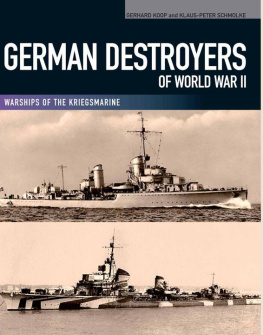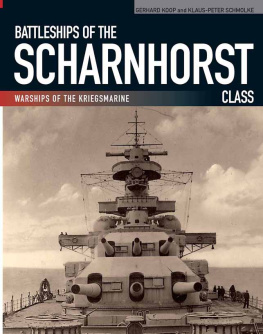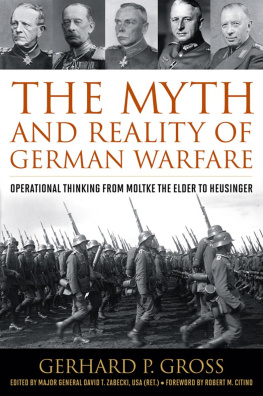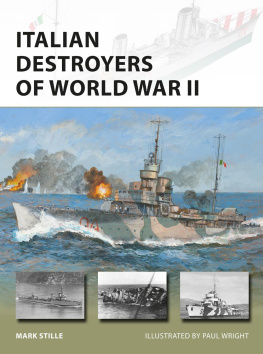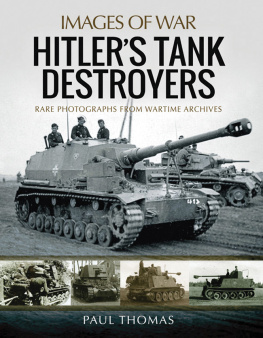Gerhard Koop - German Destroyers of World War II
Here you can read online Gerhard Koop - German Destroyers of World War II full text of the book (entire story) in english for free. Download pdf and epub, get meaning, cover and reviews about this ebook. year: 2014, publisher: Seaforth Publishing Pen and Sword, genre: Romance novel. Description of the work, (preface) as well as reviews are available. Best literature library LitArk.com created for fans of good reading and offers a wide selection of genres:
Romance novel
Science fiction
Adventure
Detective
Science
History
Home and family
Prose
Art
Politics
Computer
Non-fiction
Religion
Business
Children
Humor
Choose a favorite category and find really read worthwhile books. Enjoy immersion in the world of imagination, feel the emotions of the characters or learn something new for yourself, make an fascinating discovery.
- Book:German Destroyers of World War II
- Author:
- Publisher:Seaforth Publishing Pen and Sword
- Genre:
- Year:2014
- Rating:4 / 5
- Favourites:Add to favourites
- Your mark:
- 80
- 1
- 2
- 3
- 4
- 5
German Destroyers of World War II: summary, description and annotation
We offer to read an annotation, description, summary or preface (depends on what the author of the book "German Destroyers of World War II" wrote himself). If you haven't found the necessary information about the book — write in the comments, we will try to find it.
German Destroyers of World War II — read online for free the complete book (whole text) full work
Below is the text of the book, divided by pages. System saving the place of the last page read, allows you to conveniently read the book "German Destroyers of World War II" online for free, without having to search again every time where you left off. Put a bookmark, and you can go to the page where you finished reading at any time.
Font size:
Interval:
Bookmark:
GERMAN DESTROYERS
OF WORLD WAR II

The after single 15cm TK C/36 guns of a destroyer.
GERMAN DESTROYERS
OF WORLD WAR II
GERHARD KOOP and KLAUS-PETER SCHMOLKE

OTHER TITLES IN THIS SERIES
Battleships of the Bismarck Class
Battleships of the Scharnhorst Class
Pocket Battleships of the Deutschland Class
Heavy Cruisers of the Admiral Hipper Class
German Light Cruisers of World War II
Copyright Bernard & Graefe Verlag, Bonn, 1995
English language edition Lionel Leventhal Ltd, 2003
This edition first published in Great Britain in 2014 by
Seaforth Publishing,
Pen & Sword Books Ltd,
47 Church Street,
Barnsley S70 2AS
www.seaforthpublishing.com
British Library Cataloguing in Publication Data
A catalogue record for this book is available from the British Library
ISBN 978 1 84832 193 9
This volume is translated from Die deutschen Zestrer 19351945,
first published by Bernard & Graefe Verlag, Bonn, 1995
First published in the English language by Greenhill Books, Lionel Leventhal Ltd, 2003
All rights reserved. No part of this publication may be reproduced or transmitted in any form
or by any means, electronic or mechanical, including photocopying, recording, or any
information storage and retrieval system, without prior permission in writing of both the
copyright owner and the above publisher.
Translated from the German by Geoffrey Brooks
Printed and bound in China through Printworks International Ltd
Contents
This volume of the series introduces the destroyers of the Kriegsmarine and is a companion to five earlier volumes featuring battleships of the Bismarck class, battleships of the Scharnhorst class, the pocket battleships of the Deutschland class, the heavy cruisers of the AdmiralHipper class and the six light cruisers.
Destroyers were the workhorses of the German Fleet and were required additionally to perform duties which were really the preserve of light cruisers, which were few in number in the German Navy. Restricted by the 1919 Versailles Treaty of 1919 to sixteen destroyers each of no more than 800 tonnes and sixteen torpedo boats each not exceeding 200 tonnes, Germanys new ships of the type amounted to the six Mwe class and six Wolf class pseudo-destroyers built between 1924 and 1929. The true destroyer did not make its appearance until relatively late, coinciding more or less with the signing of the Anglo-Gernman Naval Treaty of 1935, although the first designs had been drawn up some time previously. This book explains the development stage, provides a detailed review of important facts and figures and recounts the full service history of each of the ships separately, supplemented by documentary references, War Diary extracts and combat reports. The text concludes with a critical epilogue. Also provided are detailed sketches, technical tables and a comprehensive selection of photographs, most from private collections and not previously published in this compact form; many of the illustrations appear in an English-language publication for the first time.
My special thanks go to co-author Klaus-Peter Schmolke, who prepared all plans and sketches, and I also thank F. Bavendamm, who assisted with the reproduction of the photographs, and A. Diderichs, who provided valuable advice and files relating to weapons, weapons systems and ships machinery.
Sources for photographs were: P. K. Koop Collection (149); Marine/Kriegsmarine Werft, Wilhelmshaven (1); Royal Navy (6); Royal Air Force (1); US Navy (3); private collections (41); and the MAN Archive (1).
Gerhard Koop
The post-World War I Reichsmarine continued to use the term torpedo boat for surface warships displacing less than 800 tonnes and carrying torpedoes as their primary armament, and it was not until the first true destroyers were under construction, from 1934 onwards, that the term Zerstrer (destroyer) came into vogue in Germany. The lost war brought the dissolution of the Imperial Navy, and Germany was obliged to surrender as reparations large parts of her Fleet generally the most modern units. Most of these found a watery grave as a result of the mass scuttling at Scapa Flow in 1919, and this bravado had to be paid for by handing over or scrapping further ships.
On 16 April 1919 the Germans were instructed to set up a Provisional Reichsmarine, a measure legitimised by the elected Reichstag on 30 July 1920, and the Wehrgesetz (Armed Forces Law) was passed on 23 March 1921. The scuttling of the High Seas Fleet at Scapa Flow on 21 June 1919 was a direct consequence of the dictated terms of the Versailles Treaty. As regards torpedo boats and destroyers, Article 181 stipulated that a future German Navy might have no more than sixteen destroyers and sixteen torpedo boats, four of each being in reserve. Article 190 laid down that when any of these boats was fifteen years oldcalculated from the launch dateit could be replaced by a new vessel, but a new German destroyer was not to exceed 800 tonnes, nor a torpedo boat 200 tonnes. This latter requisite was a step back into the nineteenth century, for it had been the tonnage of the very first torpedo carriers. The size and type of armament, including mines and torpedoes, ammunition and equipment, were subject to the inspection and approval of the victorious powers.
The Treaty of Versailles made it impossible for Germany to keep abreast of modern destroyer construction. Whichever way one looked at it, an 800-tonne destroyer was a torpedo boat. Nevertheless, the Reichsmarine was obliged to respect the limit with its first new boats, and thus there came into being, in compliance with Versailles, twelve destroyers, the six vessels of the Mwe class ordered in 1923 (Mwe, Seeadler, Greif,Albatros, Kondor and Falke) and the six Wolf class ships ordered in 1924 (Wolf, Iltis, Luchs, Tiger, Jaguar and Leopard) carrying three 10.5cm (4.1in) gunsthe originally intended 12.7cm (5in) armament having been disallowedand two triple sets of torpedo tubes. Speed was about 33 knots.
Personnel
Article 194 restricted the future German Navy to a personnel strength of 15,000 men, of which no more than 10 per cent could be officers or specialist deck officers, who had to be career sailors serving the colours for 25 years. NCOs and ratings signed on for twelve years. If one thinks of the numbers employed at Staff level and in the numerous shore bases alone, it can be seen how few were left to man the shipswhich explains why there were so few vessels in commission in the earlier years. With the arrival of the new light cruisers and the twelve new torpedo-boats in the mid to late 1920s, the personnel situation became desperate, and as early as 192425 the first attempts were made to introduce a clandestine short-term volunteer force of 600 men contrary to the Versailles Treaty. The SPD (Social Democratic Party) ensured that nothing came of this.
In the naval rebuilding plan of November 1932, the Reichswehr Minister approved an increase of 1,450 lower rates in the standing force and expressed the urgency for the officer corps, and the manpower situation generally, to be strengthened. Staffing was the most important naval question, but it was not until the declaration of military sovereignty in March 1935, and the signing of the Anglo-German Naval Agreement three months later, that the way was cleared to resolve the problem. From this point, however, time was of the essence, for Fleet rearmament was continuing with haste, and this adversely affected the training of the new generation of military seafarers. The Warrant Officers Corpsformed from the erstwhile deck officers of the former Imperial Navy and the backbone of the Fleethad been broken, and the best of them (and there were many) had been given commissions. Thus a new and well-qualified NCO corps had to be trained, but time for schooling ashore, and training aboard ship, had to be cut back ruthlessly. This applied to all ranks.
Next pageFont size:
Interval:
Bookmark:
Similar books «German Destroyers of World War II»
Look at similar books to German Destroyers of World War II. We have selected literature similar in name and meaning in the hope of providing readers with more options to find new, interesting, not yet read works.
Discussion, reviews of the book German Destroyers of World War II and just readers' own opinions. Leave your comments, write what you think about the work, its meaning or the main characters. Specify what exactly you liked and what you didn't like, and why you think so.

